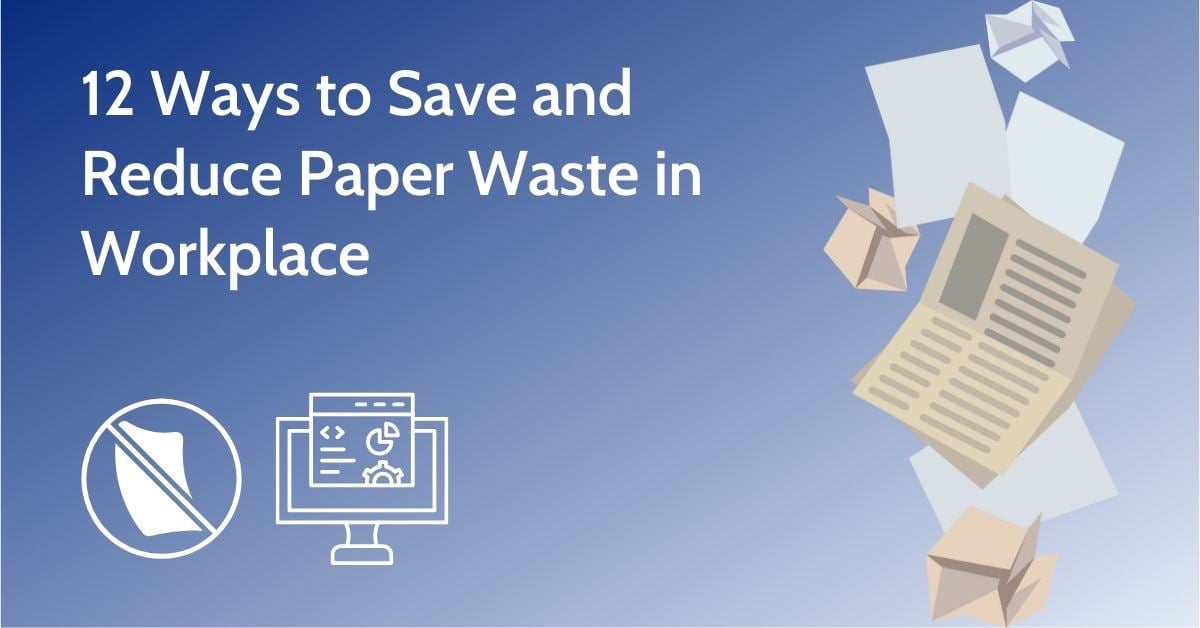12 Ways to Save and Reduce Paper Waste in Workplace

This definitive guide offers cutting-edge strategies to dramatically save and reduce paper waste in the workplace. Discover how embracing digital solutions and fostering eco-friendly habits can revolutionize your office's efficiency and contribute to a sustainable future.
1. Embrace Digital Documentation
In the modern workplace, going digital is key. By using digital tools like Microsoft OneNote, Google Docs, and Dropbox, you can create, store, and manage documents electronically. This shift not only saves vast amounts of paper but also enhances the efficiency and accessibility of your documents. It's a pivotal move toward a more sustainable and agile office environment.

2. Online Collaboration Tools
Utilize platforms like Google Workspace or Microsoft 365 to facilitate seamless document sharing and editing. You could also try a unified communications platform such as RingCentral RingEX™ that lets you do video, calls, messages, and meetings unified with real-time AI. These platforms allow multiple team members to collaborate on documents in real-time, thereby reducing the need for printed copies. This strategy not only cuts down paper usage but also fosters improved collaboration, regardless of geographic locations, enhancing overall productivity.
3. Electronic Signatures
Electronic signature tools like DocuSign and Adobe Sign are revolutionary in reducing paper usage. They allow you to sign documents digitally, eliminating the need for physical copies. These solutions are legally binding, secure, and can significantly reduce the paper trail associated with contracts and agreements.
4. Web Portal Solutions
Implement web-based portals such as Clinked or SharePoint for secure and efficient document sharing with clients and team members. These portals reduce the need for physical mail and printed materials, providing a convenient and eco-friendly alternative for document exchange and collaboration.

In addition to streamlining communication, these web portals offer robust features like real-time editing, version control, and customizable access permissions. This ensures that sensitive documents remain secure while allowing for collaborative efforts across different departments or locations.
The use of such platforms can significantly enhance project management efficiency, allowing team members and clients to track progress, assign tasks, and consolidate feedback in a centralized, easily accessible space. This not only accelerates the decision-making process but also fosters a more cohesive and responsive working environment.
See how Clinked can help you collaborate on documents with its powerful tools for document management.
5. Cloud Storage Efficiency
Cloud storage services like Google Drive or Microsoft OneDrive offer a secure and accessible solution for document storage and sharing, significantly reducing the need for printed records. By storing documents digitally, you enable easy access from multiple devices and ensure that everyone has the latest version, promoting a more collaborative and productive workplace.
6. Digitalize with Scanning
For offices dealing with a high volume of paper documents, investing in quality scanners, QR maker tools and document management software is essential. This approach allows you to digitize and efficiently organize physical documents, making them easier to search, retrieve, and share, thereby reducing the reliance on paper.

7. Digital Communication
Embrace digital communication methods such as email, Slack, or text messages for internal communications. These methods are not only environmentally friendly but also ensure that messages are delivered instantaneously and can be easily referenced.
8. Online Forms
Transition to online forms for internal and external use. Tools like Google Forms and Jotform facilitate efficient data collection and processing without the need for paper forms. This approach is not only eco-friendly but also streamlines various administrative processes.

9. Centralized Printing
Reducing the use of personal printers and centralizing printing operations can significantly control paper usage. By having a shared printer area, you can monitor and manage paper consumption more effectively, encouraging responsible printing practices.
10. Double-Sided Printing
Encourage double-sided printing as a default setting on all office printers. This simple yet effective change can reduce paper consumption by half. It’s an easy-to-implement strategy that has immediate positive effects on your paper usage and environmental impact.
11. Print Judiciously
Promote a culture of mindful printing. Encourage employees to consider whether a hard copy is necessary before printing. Often, digital versions are sufficient and more efficient for both sharing and archival purposes, significantly reducing unnecessary paper use.
12. Responsible Recycling
Establish a comprehensive recycling program in your workplace. Place recycling bins in accessible locations and educate your team about the importance of recycling carton and paper. It’s also crucial to ensure the secure disposal of confidential documents to maintain privacy and data security.
Wrapping it Up
Transitioning to a paperless or reduced-paper workplace is more than a trend; it’s a strategic move towards sustainability and efficiency. By implementing these 12 strategies, and utilizing paperless document management systems, your organization will not only contribute to environmental conservation but also enjoy enhanced operational efficiency and cost savings. Remember, every step towards reducing paper usage counts towards a greener, more efficient, and successful future.
As you embark on the journey to reduce paper waste in your workplace, keep in mind that the transition may require time and adjustment, but the long-term rewards are well worth the effort. Your organization can cut costs, reduce its environmental impact, and create a more efficient and eco-conscious work environment.
Thank you for reading, and we hope these tips inspire positive change within your organization!